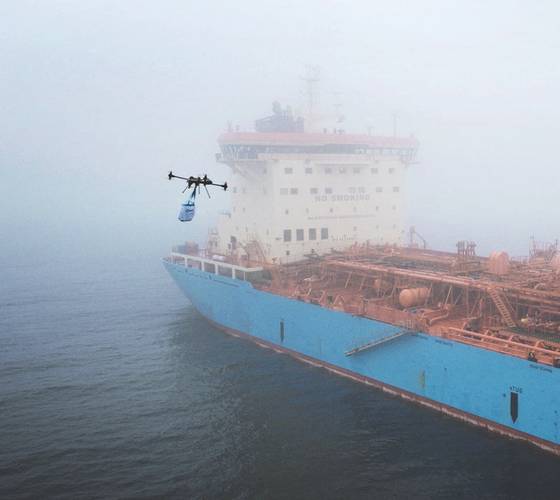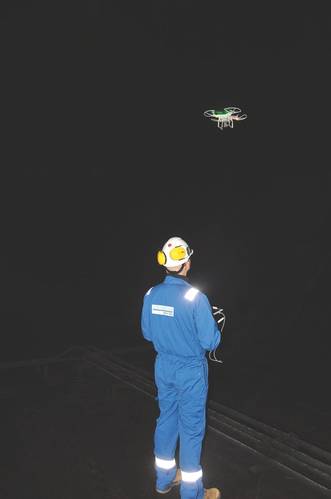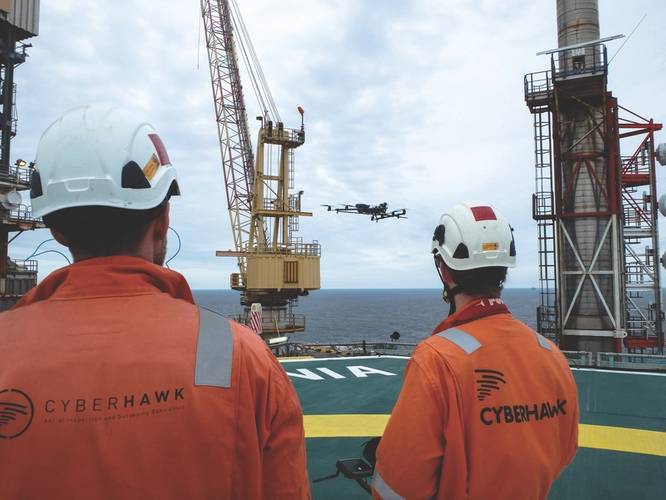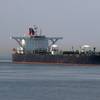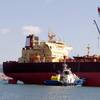Unmanned aerial systems (UAS), or “drones” in common parlance, are not a part of the historical maritime vocabulary. At least not yet. While the term “drones” may conjure images from science fiction, the reality is that companies are designing commercial UAS for the private sector, and they are gradually permeating our daily life. Henry Ford is rumored to have opined on his invention of the automobile that if he had asked people what they wanted, they would have said “faster horses.” In the case of UAS, they are quickly evolving into a useful maritime business tool due to the innovative opportunities they provide.
From the first merchant vessels that plied the seas, technology in the maritime industry continues to evolve, as witnessed with gradual acceptance and implementation of containerization, Global Positioning System (GPS), and Electronic Chart Display and Information System (ECDIS). Now, UAS harken yet another new frontier for the maritime industry. Accordingly, UAS may afford the maritime industry a novel approach to cost and time savings, and clients should be poised to harness the potential advantages UAS offer. In other words, in order to survive and evolve, the maritime industry should not search for “faster horses” for everyday maritime endeavors, and UAS provide an evolving list of potential uses in the maritime, energy, shipping, offshore, and ship construction markets.
While UAS were initially developed for government and military operations, over the next five years, growth in the commercial and civilian market of the UAS industry is generally predicted to surpass that of the defense industry. But, while research, development, and manufacturing for UAS technology continues to rapidly evolve, regulators have been struggling to keep pace. Consequently, the legal issues that surround the use of UAS remain complex, and in some areas, unsettled. And, as with any new innovation, there are benefits and risks, and commercial UAS are no exception. Nonetheless, as the use of UAS becomes more prevalent in the maritime industry, this articles offers an awareness of the practical areas in which unmanned aerial vehicles can have a positive impact across the maritime industry, and provides recommendations to assist clients so they can position themselves to take advantage of the progresses in UAS technology as they navigate largely uncharted waters.
The Cookie Test and What Follows Next
The following is a summary of key developments in particular segments of the maritime industry.
Resupply at Sea
Currently, in order to send urgent medical supplies, mail, documents, spare parts, provisions, and the like to a vessel underway or at anchor, owners and operators must rely on conventional means for delivery, such as boats, barges, or sending the vessel to port to tie-up alongside a pier. However, these options are time-consuming and expensive, with barges costing at least $1,000. The reality is that resupplying a vessel is a common occurrence, and in some cases, supplies are needed when the vessel is still far out to sea or with a next port of call yet undetermined.
Owners and operators are limited in available options for urgent deliveries to vessels, but those limitations are dissipating. In January 2016, a UAS operated by A.P. Moller Maersk A/S successfully completed an at-sea delivery of a small package to a tanker through the use of an aerial UAS. Maersk conducted this UAS test over a relatively short distance of 247 meters, and the package contained Danish butter cookies weighing a little less than three pounds.
Even though the flight distance in this case was somewhat short, industry should be optimistic that as technology advances, future deliveries could involve longer flight distances, heavier payloads, and a wider variety of uses. As UAS integrate into the maritime sector’s supply chain, companies may provide savings of thousands of dollars per vessel each year on small yet essential vessel deliveries In other words, a UAS effectively limits or alleviates the need to pay to hire a boat, crew, and fuel to make deliveries, and also increases safety in dangerous sea conditions as the human element is reduced in the at-sea transfer. Also, the advantages with the use of UAS in shipping extend beyond delivery of supplies to all types of vessels. Other proposed uses could include inspections of tanks aboard tank and cargo vessels, and lashing aboard cargo or container ships. In some cases, UAS may become valuable surveillance tools that enhance vessel safety in ice navigation and surveillance in anti-piracy measures.
Offshore Energy—Oil, Gas, and Wind
Besides resupplying vessels, companies are increasingly utilizing UAS in the energy sector in performing inspection work. Experts suggest that UAS are capable of operating in some the most challenging environments in the offshore industry, and could be used to meet requirements before oil and gas exploration is approved, such as those related to surveys of ice and marine life. UAS can survey and identify elements of a rig or vessel for leaks, damage to piping, structural defects, or other irregularities in locations that are difficult to access or dangerous for human intervention, such as offshore risers, flare stacks, and undersides of offshore structures. Also, UAS could assist in complicated inspection and survey work in circumstances in which a class survey may be required, including hull tank inspections in confined spaces.
To illustrate, over the past few years several companies have already conducted numerous operational tests in the offshore energy sector. For example, in January 2016, a UK-based firm reportedly conducted a UAS inspection in the Gulf of Mexico aboard a drillship. The UAS completed the inspection of the derrick, a heli-deck, and four cranes in two days, more than two weeks shorter than estimates of what would have been required under current inspection options. And, UAS can foreseeably be used for faster gathering of information to detect and quantify discharges or spills in an effort to mitigate environmental impact in times of disaster.
Besides oil and gas exploration, UAS are being tested in inspections of offshore wind turbines in efforts to both decrease the economic losses caused during lengthy turbine inspection downtimes and enhance safety for technicians typically required to climb on the blades for repair or to complete an inspection. As a market, the cumulative global revenue for UAS sales and inspection services “for wind turbine is expected to reach nearly $6 billion by 2024.”
Shipyard Inspections and Class Society Surveys
Keeping pace with other maritime sectors, overseas shipbuilders are employing UAS technology during various construction and inspection stages in efforts to save time and money and increase efficiency. Last year, Poland’s Remontowa Shiprepair Yard began flying a UAS to inspect internal spaces of chemical and product tankers. During the overhaul, the UAS accessed the cargo tanks to provide a general assessment of the condition of the hull and bulkheads, and saved time by alleviating some time-consuming tasks such as scaffolding set-up. The shipyard foresees expanding inspections to other areas of the vessel, such as the masts or deck crane jibs. Also, Japanese shipbuilder Tsuneishi Holdings Corporation and Turkish Besiktas Shipyard have been using UAS at their respective shipyards to assist in vessels undergoing repairs.
More recently at the Posidonia 2016 trade fair, Knut Ørbeck-Nilssen, CEO of DNV GL – Maritime, reported that DNV GL had tested the use of UAS to conduct surveys inside ship tanks aboard the chemical tanker MV Apollo. Ørbeck-Nilssen noted that DNV GL was now positioned as the “first classification society to complete production surveys using a UAS to assist surveyors,” an accomplishment garnering attention from the maritime industry.
Port and Terminals
As a complement to current available technology, cargo ports and terminals are taking steps to monitor the yards, and vessel operations may consider UAS to enhance management of a terminal. Foreseeably, UAS could be used to augment port security plans. Most recently, Abu Dhabi Ports Company began testing the use of UAS to increase the surveillance at ports in and around Abu Dhabi. And, the Maritime and Port Authority (MPA) of Singapore intends to use UAS in lieu of a boat to monitor oil spills or other marine incidents in the port’s waters. Furthermore, Protection and Indemnity (P&I) Clubs could use this same technology in lieu of U.S. Coast Guard overflights for oil spills, resulting in significant reductions in response costs.
Government Contracts and Grants
As UAS capabilities increase, governmental agencies continue to search for additional uses for them in support of various statutory authorities and national security interests. Federal agencies such as the U.S. Coast Guard are actively conducting market research with UAS to support statutory missions such as law enforcement, immigration, fisheries, and counter-drug and smuggling surveillance operations, among others. In fact, the U.S. Coast Guard Research and Development Center has entered into cooperative agreements with several companies to evaluate small unmanned aircraft systems for potential for use in maritime environments, such as the Arctic, and for law enforcement, search and rescue, and maritime environmental response. The Coast Guard has also indicated that a UAS could be used to assist with navigation through ice in the Great Lakes.
Besides the Coast Guard, the National Oceanic and Atmospheric Administration (NOAA) is using UAS to collect data from dangerous or remote areas to survey living marine resources and environmental conditions. Also, the U.S. Navy continues to integrate unmanned aircraft into ever-increasing areas. Notably, in 2014, the Navy successfully took off and landed an unmanned aircraft from an aircraft carrier alongside a manned aircraft. The following year, Navy Secretary Ray Mabus opined that the service’s F-35C “should be, and almost certainly will be, the last manned strike fighter aircraft the Department of the Navy will ever buy or fly.” Currently, the Navy is trying to build a next-generation UAS that it can launch from an aircraft carrier and refuel in mid-air, recently awarding a $93.1 million contract to a defense contractor for this purpose. The Navy has also established two new offices dedicated to integration of unmanned systems, and will look to all aspects of industry to meet their acquisition needs.
Besides contracts, federal agencies like the U.S. Department of Defense offer financial funding through a grant program, the Small Business Innovation Research (SBIR), related to developing a spectrum of UAS technologies.
Grants may also be available at the state level, such as in New York, related to integrating UAS into commercial airspace.
Overall, procurement, acquisition, and grants related to UAS look to be a growth market over the next decade.
UAS Regulatory and Legal Regimes—Murky Waters or Smooth Sailing?
So, what does it take to operate a UAS in the maritime industry? The short answer: it depends. The location and use of the UAS operations may call into play multiple overlapping jurisdictional concerns, including domestic and international legal obligations. Under the current state of the law, the FAA regulates and has “exclusive sovereignty” over the airspace of the United States and regulates commercial UAS use as “aircraft.” The FAA authorizes commercial UAS purposes through what is known as a “Section 333 Exemption” of the FAA Modernization and Reform Act, and grants these exemptions on a case-by-case basis for UAS to conduct commercial operations. An exemption provides permission from the FAA, with several restrictions on variables such as altitude, speed, and airspace, but the application approval process is time-consuming. And, operators may also require an FAA Certificate of Waiver or Authorization (COA), which grants access for specific UAS activity within the national airspace.
Additionally, operators must be aware of potential state and local government regulations in areas not specifically reserved to the FAA, such as trespass, property, privacy, or nuisance laws. Consequently, the enforcement landscape at the federal, state, and local level in many cases lacks conformity, requiring constant vigilance of developing legal regimes. Given the operational limitations of the 333 Exemption and the potential need for a COA, careful consideration should be given in each case as to what requirements must be met before operating. Additionally, commercial use operators must be cognizant of potential flight restrictions that governments may develop for national security reasons.
Outside of U.S. airspace, operators must be cognizant of the domestic laws related to UAS, which may vary from country to country. To illustrate, the European Aviation Safety Agency (EASA) is currently developing new UAS rules, but acknowledges that civil operators currently rely on basic national safety rules given the current regulatory regime. Adding an additional layer of complexity are international organizations such as the International Civil Aviation Organization (ICAO) and the International Maritime Organization (IMO), which may be applicable to UAS operations in international airspace. By 2018, the ICAO hopes to deliver an unmanned aircraft international regulatory framework to its 191 member states, who would then still need to set their own national regulations. Additionally, the IMO may have a role in recommendations on UAS standards which could have an impact on, for example, use of UAS by vessels at sea for search and rescue, rendering assistance at sea for distressed mariners, monitoring maritime migrant flow, or for use by cruise ships in polar regions to aid ice navigation.
Essentially, innovators outpaced the regulators, and agencies such as the FAA were relatively unprepared for the influx and demand of commercial UAS. As a result, the FAA has been struggling mightily to keep up, but has indicated a willingness to work with the industry on the issue. However, the maritime sector, and other commercial industries, are currently left with a shifting legal landscape in both domestic and international regulatory schemes that may lack clear comity or consistency. And, under the current legal regime, UAS operators who fail to adhere to the various jurisdictional and legal requirements risk license revocation, seizure, and fines among other civil and criminal penalties. But, if the maritime industry cautiously navigates these legal regimes, the benefits could very well outweigh the risks.
Risks and Liability Insurance for Industry
Admittedly, assimilation of UAS into the maritime industry has hurdles to overcome, and liabilities such as collision, third-party damage, and injury are all variables that should be considered. Currently, the full range of data is still being developed on which to measure all the risks that UAS pose in the maritime sector. This presents challenges to the industry as well as to insurers. And, one of the most significant liabilities when operating a commercial UAS is that of cybersecurity (i.e., malicious actors “hacking” or “spoofing” the UAS), a liability topic that is rapidly developing.
In order to meet liabilities, UAS operators should consider whether they have sufficient levels of insurance, such as hull, casualty, loss, and product liability in the event of an accident. Overall, while it is clear that UAS have a number of attendant risks, their wide-ranging uses also have the potential to benefit the maritime industry, but prudence would dictate seeking legal assistance to conduct a due diligence review of UAS risks well in advance of any UAS flights.
Conclusion
In sum, UAS offer flexibility for a broad number of business opportunities that may reduce cost and time in the maritime sector, while integrating into existing maritime safety practices and operations. In view of these developments, industry stakeholders should focus on UAS now, depending on their business challenges, and consider whether now is the time to enter this market, ahead of the curve and in front of their competitors. Given the complex legal and regulatory landscape in which UAS operate, clients should consult with counsel as part of their UAS review to assist in evaluating regulatory, technical, legal, and public policy issues in order to prudently mitigate risk while assisting with business solutions.
The Author
Sean T. Pribyl, associate at Blank Rome, concentrates his practice in the areas of maritime, investigations, unmanned systems, cybersecurity, and white collar defense. He worked as a licensed mariner for eight years, and spent six years on active duty in the U.S. Coast Guard legal program, serving as the operational legal expert and advisor to unmanned systems. He is a member of the Maritime Law Association Cybersecurity Committee.







